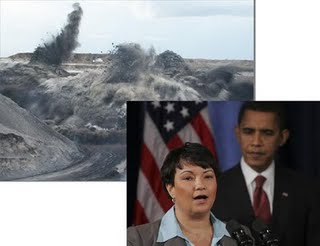A moment of truth has arrived for the U.S. Environmental Protection Agency (EPA) and President Barack Obama, who has promised “unprecedented steps” to rein in the devastating practice of mountaintop removal coal mining that is wrecking havoc across wide swaths of Appalachian mountains, valleys and communities.
 Anti-mountaintop removal activists are hoping President Obama and EPA Administrator Lisa Jackson are about to make good on past promises to crack down on the destructive practice.Courtesy Jesse Jenkins / Energy CollectiveEPA is expected to announce decisions this week on over 100 pending permits for new or expanded coal mining projects utilizing mountaintop removal (MTR), which uses huge amounts of explosives to decapitate mountains and access the coal beneath, dumping the remains of these once-verdant Appalachian peaks directly on top of neighboring valleys and streams.
Anti-mountaintop removal activists are hoping President Obama and EPA Administrator Lisa Jackson are about to make good on past promises to crack down on the destructive practice.Courtesy Jesse Jenkins / Energy CollectiveEPA is expected to announce decisions this week on over 100 pending permits for new or expanded coal mining projects utilizing mountaintop removal (MTR), which uses huge amounts of explosives to decapitate mountains and access the coal beneath, dumping the remains of these once-verdant Appalachian peaks directly on top of neighboring valleys and streams.
Mountaintop removal mining has already buried more than 800 miles of Appalachian streams and destroyed hundreds of square miles of woodlands in one of America’s biodiversity hotspots, all while both the U.S. EPA and state environmental agencies have done little to curtail the practice. That’s left it to activists to slow these projects down and prevent their irreversible damages.
But if recent news that the EPA is seeking to revoke the permit for the largest mountaintop removal mining project in West Virginia history is any indicator, the agency may finally be earning the “Protection” part of their name.
With a self-imposed, September 8th deadline now expired, the EPA is expected to issue an “initial list” this week identifying pending mountaintop removal projects that pose potential environmental concerns. The projects under EPA review have already been approved by the U.S. Army Corps of Engineers (the Corps), which has primary responsibility for approving surface mining projects. Any projects that EPA decides will have no “significant” environmental impact will sail forward “without further coordination with EPA,” according to agency procedures (kindly explained by Coal Tattoo‘s Ken Ward Jr. here).
Projects posing an environmental risk – and any sane person is hard pressed to explain how blowing up a mountain has no environmental impact – will instead show up on a list sent to the Corps, triggering a process of further review and ultimately – if EPA does it’s job right – the rejection of some if not all of these proposed mountaintop removal projects under the Clean Water Act.
For better or worse, the forthcoming EPA list of environmentally risky projects will mark an important step closer to the establishment of clear, public standards for what level of environmental impact the agency will allow or prohibit at MTR sites proposed throughout Appalachia. The EPA has so far avoided establishing any such clear public standard.
With hundreds of mountaintop removal sites now in the balance, this is the moment of truth for the EPA, Administrator Lisa Jackson, and President Obama to make good on promises to reign in this clearly environmentally devastating practice. As EPA Administrator Lisa Jackson explained on National Public Radio last week:
EPA has committed to reviewing [mountaintop removal mining] projects. It’s been a contentious issue from the start, certainly in Appalachia. We are in the process of reviewing about 84 permits right now that were put on hold by litigation. And in the next few weeks we’re going to have to make a determination under the Clean Water Act as to whether those permits can meet the Clean Water Act standards or whether they should be held up and potentially ultimately vetoed. EPA has the authority to veto the permits. The permits themselves are issued by the U.S. Army Corps of Engineers. So EPA plays sort of an oversight role there.
As we wait for the EPA’s decision on the dozens of pending MTR permits, the Agency moved forward on a seperate front to block the largest proposed mountaintop removal site in West Virginia history in letter sent to the U.S. Army Corp of Engineers late last week.
Read the full story at www.WattHead.org, the new home of WattHead – Energy News and Commentary



